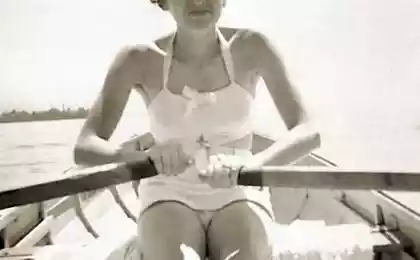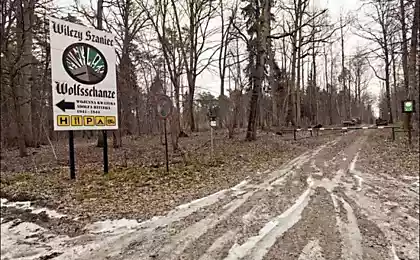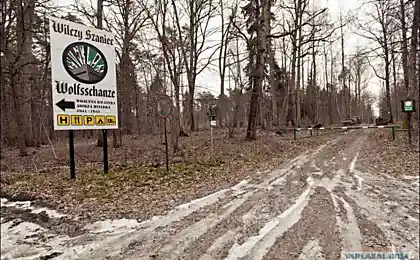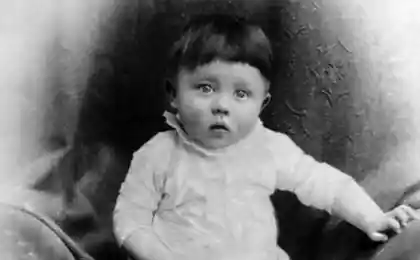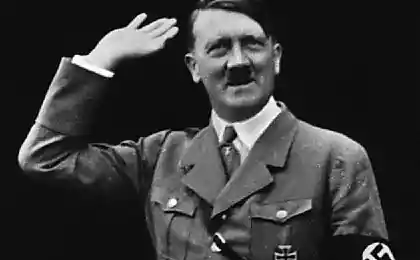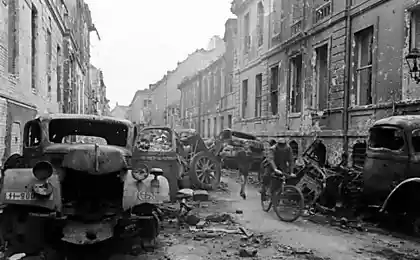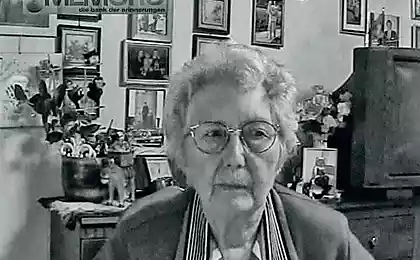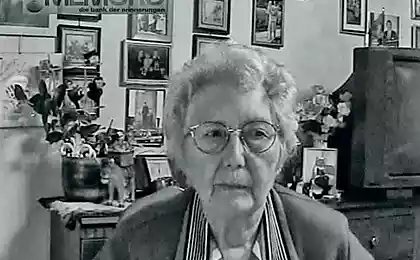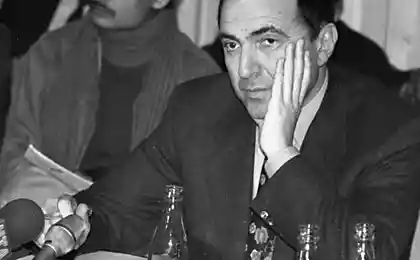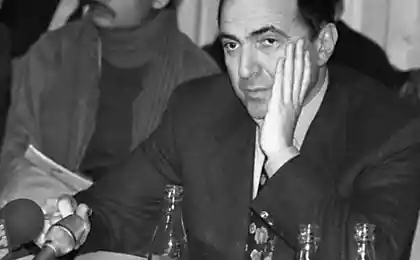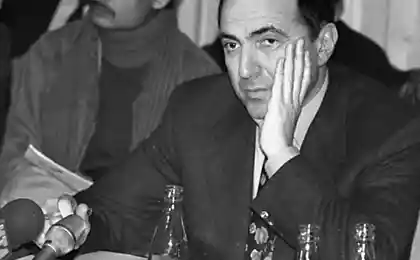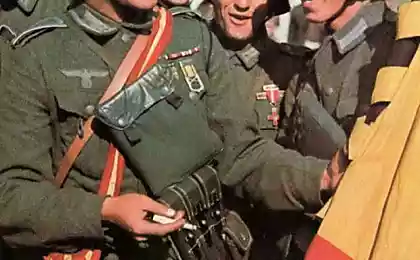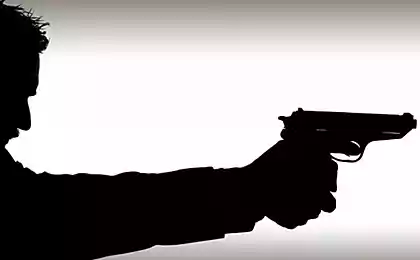968
Six attempts on Hitler's life (9 photos)
March 1, 1943 held a failed assassination attempt against Adolf Hitler chancellor of Germany. Führer left the exhibition of Russian art trophy before had prepared for him to explode mines. Throughout his life, Hitler was committed to it, according to various estimates, from 20 to 50 attempts, and many of them have failed not because of the vigilance of protection, and by a happy coincidence for the dictator.

The consequences of the explosion in "Bürgerbräukeller." Photo: Gestapo / AP
Otto Strasser, 1936
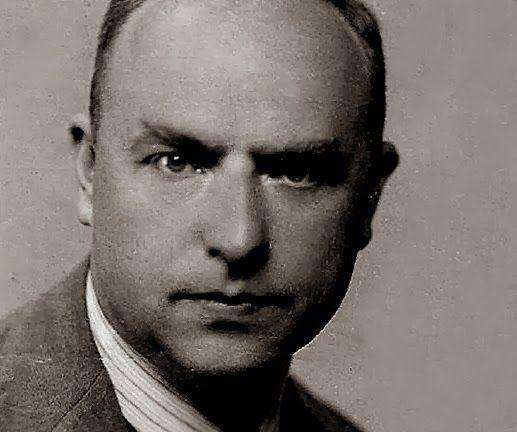
A former member of the Nazi Party, Otto Strasser in 1931 created his own movement - the Battle of the revolutionary alliance of the National Socialists, who criticized Hitler and the Reich Minister of the Interior Heinrich Himmler, was unhappy too liberal economic course and delayed the self "true socialists". Immediately after coming to power of the Führer in 1933. "Black Front" (also known as the Fighting Union) was banned, some of its members sent to concentration camps, and Strasser fled to Czechoslovakia. The "Night of the Long Knives," June 30, 1934, when there was a massacre of the left wing of the Nazi Party, was killed by his older brother Gregor Strasser.
In 1936 he persuaded the younger Strasser living in Prague German Jewish students Helmut Hirsch back to Germany and to kill someone from the leadership. Thirsty for revenge for the persecution of the Jews Hirsch, in addition to Hitler, he was going to kill the chief editor of the antisemitic newspaper "Sturmer" Julius Streicher. It was planned to bomb during the next Congress of the Nazi Party in Nuremberg.
Hirsch arrived in his native Stuttgart on December 20, three days before the meeting with Strasser supporter, who took over the production of bombs. The student did not know what to with explosives has been arrested on the German-Polish border, and in the interrogation the Gestapo arrested confessed and passed the name of the artist. Inexperienced Jew used his real name in the hotel questionnaire for guests, and it very quickly found. March 8, 1937 Hirsch was sentenced to death by beheading. The sentence was carried out on July 4 in Plettsenzee prison in Berlin.
Maurice Bavo, 1938
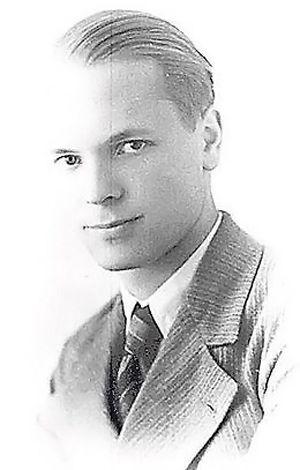
Persistent, but not having success in their quest to kill Hitler were theology students from Lausanne Moris Bavo. He was not involved in any organization and thought through scheme to assassinate its own, which clearly did not play into his hands. The first time a student has decided to deal with the Führer November 9, 1938 during the celebration of the fifteenth anniversary of the "Beer Hall Putsch" in Munich. He went to Germany in secret from his family, previously stolen from the house of 600 francs, which bought the gun. Not having any idea about the shooting, Bavo presented to reporters, to get an invitation to the podium for the audience ten meters away from the place where Hitler had to go through. The dictator used to go out and go to the head of the column toward the podium. However, when the shooter is responsible for the moment has come, supporters raised their hands in greeting the Fuehrer and blocked his goal. Crawl through police barriers to the place of performance chancellor Bavo also failed.
The next day the student was trying to get to the residence of Hitler's Obersalzberg. At the entrance Bavo said that must transmit a letter to the Führer, but he was not allowed inside. He ran out of money a student tried to go to Paris without a ticket, but the train was detained. During the search he found a pistol and fake recommendation letter to the Reich Chancellor. During the interrogation, the young man confessed to his plans and said that Hitler was a threat to Switzerland and the whole of humanity. After 30 months of camps and prisons Bavo were guillotined May 14, 1941.
Johann Georg Elser, 1939
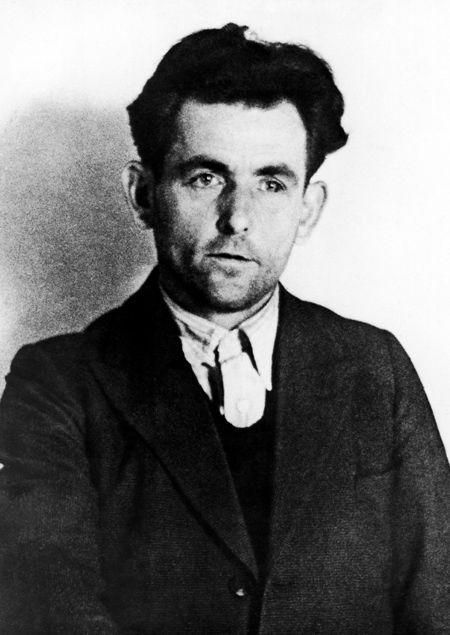
On the day when the "ridge" prevented Bavo shoot Hitler, German carpenter communist Johann Georg Elser was waiting for the end of the holiday. When everyone had gone, and with the protection of the beer hall "Bürgerbräukeller" was shot, he was able to calmly explore the room and choose a location for the bomb. Hitler spoke to veterans each year of the National Socialist Workers' Party with a speech in honor of the anniversary of the "Beer Hall Putsch", so a communist could be sure that, after 365 days of the Fuehrer will be right there.
In the summer of 1939 he took Elser in Munich apartment and began to prepare for the assassination. Coming to "Bürgerbräukeller" He was hiding in the closet for brooms, after the closure of establishments to be able to prepare the explosion. In fact, to make a hole in the column, next to which is usually located Tribune Hitler and insert the improvised explosive device had gone Elser month. November 8, 1939, he hooked up to bomb fuzes hour.
Fuhrer saved sudden departure from the usual schedule: usually Hitler began broadcasting at 20:30 and ended at 22:00, so the carpenter-terrorist detonator set to 21:20. But this time the Fuhrer had more important things, since he had recently invaded Poland. He began his speech half an hour earlier and spoke an hour. When the explosion occurred, Hitler in the hall was gone.
Along with the beer column roof collapsed, debris filled up the podium. 8 people died, 63 were injured. Elser was detained on the border with Switzerland, and was identified as the organizer of the explosion on the multi-day operation of the swollen knees. He was sent to Dachau concentration camp. April 9, 1945 Carpenter was executed on the orders of Hitler as a "special prisoner". And the fate of the stored Führer became more powerful in the eyes of their supporters.
Conspiracy military in 1943
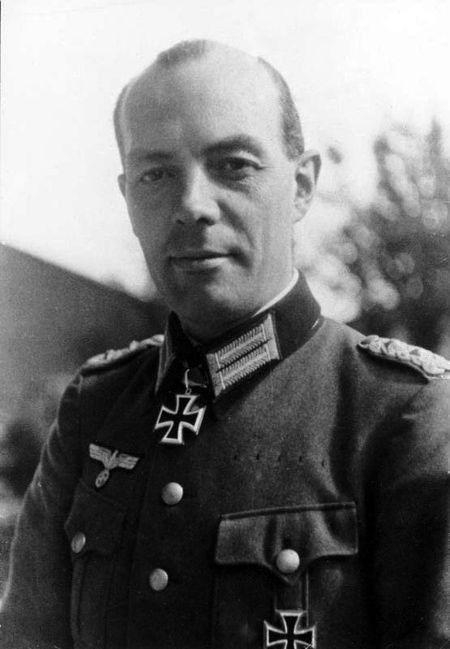
Rudolf Christoph von Gersdorff. Photo: Federal Archives of Germany
On the eve of the commemoration of the fallen heroes in Berlin intelligence chief of Army Group "Center" Colonel Rudolf Christoph von Gersdorff met one of the leaders of the military conspiracy Fabian von Shlabrendorfom, who took the two mines. These detonators were set at ten minutes, but due to the low room temperature Tseyghausa, where an exhibition, the time to explosion was increased to 15-20 minutes.
March 21, 1943, Hitler had come accompanied by Himmler, Reich Marshal Hermann Goering and chief of staff of the Supreme Command of the Armed Forces Wilhelm Keitel. Thus, apart from the possibility to go to the Führer close enough, the event gave a chance at the same time commit Gersdorff and his closest associates. Bombs Colonel intended to smuggle into the pockets of his overcoat.
According to the program of the ceremony, after Hitler oration was going to devote half an hour to get acquainted with the Russian trophy technique, exhibited in glass-covered courtyard Tseyghausa. However, at the last moment it turned out that there were changes in the schedule and the Chancellor will spend a viewing exhibits from eight to ten minutes. Since the explosion of mines would need more time, the implementation of the planned proved to be impossible.
Another military conspiracy, 1944
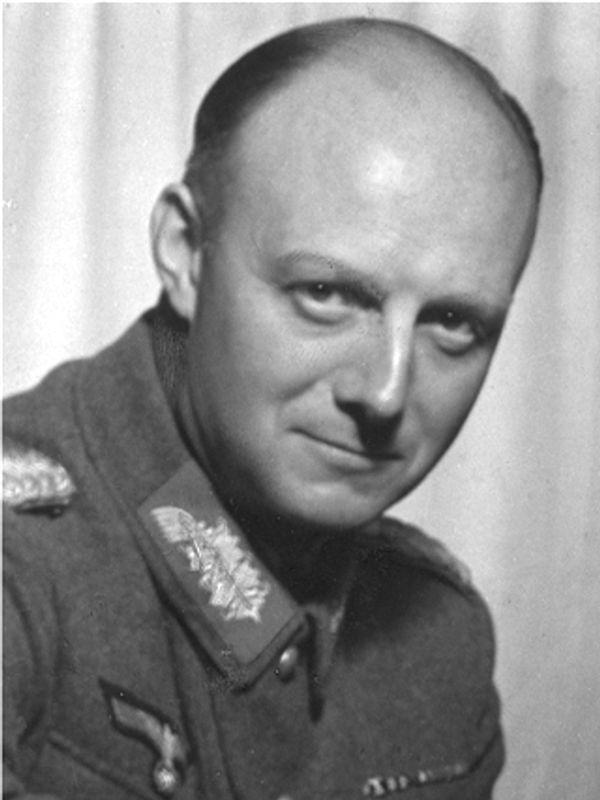
March 11, 1944 attempt to assassinate Hitler committed orderly Field Marshal Ernst Busch Eberhard von Braytenbuh adopted in the plot by Colonel Henning von Treskova, who led the military in 1941 tried to kill the Führer. Braytenbuh accompanied Bush to a meeting of generals in Hitler at Berchtesgaden. When the orderly announced plans cod offered him the explosives, but Braytenbuh said that he's a great shooter, and he will need a few seconds to get a gun and shoot Hitler in the head. He did not doubt the success of his ideas, and at the same time knew that after her performance of the SS might shoot him.
On the day of the meeting, Bush and his assistant with the rest of the military were waiting for him in front of the beginning. When Major SS opened the door to the conference room, the meeting began to enter into it in a hierarchy ranks. Braytenbuh as the most junior in rank, was in the last stage. The SS man stopped orderly and informed him that the senior officers of the assistants to the meeting entry is prohibited. Bush has tried to insist that it requires the presence of his subordinates, but the major was adamant and said that this was a personal decision of Hitler.
Left in front alone, Braytenbuh spent several anxious hours. He thought that someone had warned the Fuehrer about the impending assassination attempt, so every time you passed by orderly SS guard, he was preparing for the worst. Around noon, the meeting ended and Braytenbuh caution came out for his boss, all the while looking around in anticipation of the arrest.
Conspirator never learned the reason for which he was not allowed to meet in the rate. It seems that the amazing success of Hitler - the only explanation for that.
20 July plot
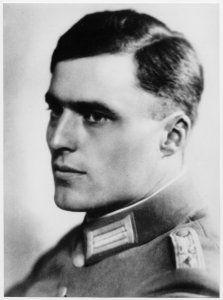
Adolf Hitler tried to blow up more than once, but always to no avail. Among the high-ranking military, who could organize an attack, enough opponents of Nazism - among them were the deputy commander of the Reserve Army, General Friedrich Olbricht, Field Marshal Erwin von Witzleben, Colonel Henning von Tresckow and others. Cod and headed a group that tried to assassinate Hitler in 1941.
In March 1943, the conspirators put a bomb on the plane of the Fuhrer, who flew to Smolensk, but the device did not work out. After eight days of Colonel von Gersdorff he was going to put an end to Hitler exploding with it at an exhibition of trophies, but the dictator left the event earlier than planned assassination.
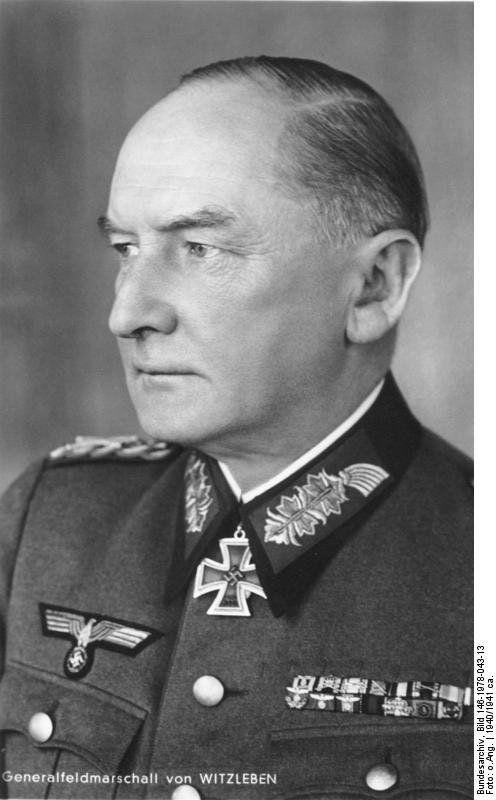
In August 1943, Tresckow had met with Colonel Claus von Stauffenberg, who ten months later was promoted to colonel and chief of staff of the reserve army, having the opportunity to attend meetings at Hitler's headquarters "Wolfsan" ("Wolf's Lair"). Double - 6 and July 15 - the operation fails. On the morning of July 20, 1944 Stauffenberg was at stake with the report, carrying the two portfolios, one of which was an explosive.
The circumstances are unfavorable at the outset: the meeting started half an hour earlier than the scheduled time, in addition, it suffered from an underground bunker in wooden barracks. Stauffenberg put the briefcase with the activated bomb a few meters away from Hitler and left. His place was taken by another officer who moved the portfolio to disturb him on the opposite side of the table so that the Fuehrer turned enclosed by a wooden pedestal. When the explosion occurred, four of whom were in a room of people were killed, but Hitler escaped with concussion and minor injuries.
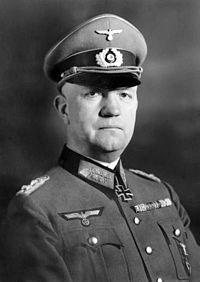
Closer to the night the commander of the reserve army Friedrich Fromm, the conspirators agreed to help only in case of death of the Fuhrer, arrested them. Stauffenberg, Olbricht and Colonel Kvirnhayma military tribunal sentenced him to death, and they were immediately shot. Other participants of the conspiracy was less lucky: on the orders of Hitler hung "like cattle to the slaughter" - on the piano wire attached to a hook on the ceiling. Total of involvement in the assassination were executed 200 people. Unable to avoid this fate and to Fromm.
Cod, learn about the failure of the operation, committed suicide by faking death from enemy grenades.

The consequences of the explosion in "Bürgerbräukeller." Photo: Gestapo / AP
Otto Strasser, 1936

A former member of the Nazi Party, Otto Strasser in 1931 created his own movement - the Battle of the revolutionary alliance of the National Socialists, who criticized Hitler and the Reich Minister of the Interior Heinrich Himmler, was unhappy too liberal economic course and delayed the self "true socialists". Immediately after coming to power of the Führer in 1933. "Black Front" (also known as the Fighting Union) was banned, some of its members sent to concentration camps, and Strasser fled to Czechoslovakia. The "Night of the Long Knives," June 30, 1934, when there was a massacre of the left wing of the Nazi Party, was killed by his older brother Gregor Strasser.
In 1936 he persuaded the younger Strasser living in Prague German Jewish students Helmut Hirsch back to Germany and to kill someone from the leadership. Thirsty for revenge for the persecution of the Jews Hirsch, in addition to Hitler, he was going to kill the chief editor of the antisemitic newspaper "Sturmer" Julius Streicher. It was planned to bomb during the next Congress of the Nazi Party in Nuremberg.
Hirsch arrived in his native Stuttgart on December 20, three days before the meeting with Strasser supporter, who took over the production of bombs. The student did not know what to with explosives has been arrested on the German-Polish border, and in the interrogation the Gestapo arrested confessed and passed the name of the artist. Inexperienced Jew used his real name in the hotel questionnaire for guests, and it very quickly found. March 8, 1937 Hirsch was sentenced to death by beheading. The sentence was carried out on July 4 in Plettsenzee prison in Berlin.
Maurice Bavo, 1938

Persistent, but not having success in their quest to kill Hitler were theology students from Lausanne Moris Bavo. He was not involved in any organization and thought through scheme to assassinate its own, which clearly did not play into his hands. The first time a student has decided to deal with the Führer November 9, 1938 during the celebration of the fifteenth anniversary of the "Beer Hall Putsch" in Munich. He went to Germany in secret from his family, previously stolen from the house of 600 francs, which bought the gun. Not having any idea about the shooting, Bavo presented to reporters, to get an invitation to the podium for the audience ten meters away from the place where Hitler had to go through. The dictator used to go out and go to the head of the column toward the podium. However, when the shooter is responsible for the moment has come, supporters raised their hands in greeting the Fuehrer and blocked his goal. Crawl through police barriers to the place of performance chancellor Bavo also failed.
The next day the student was trying to get to the residence of Hitler's Obersalzberg. At the entrance Bavo said that must transmit a letter to the Führer, but he was not allowed inside. He ran out of money a student tried to go to Paris without a ticket, but the train was detained. During the search he found a pistol and fake recommendation letter to the Reich Chancellor. During the interrogation, the young man confessed to his plans and said that Hitler was a threat to Switzerland and the whole of humanity. After 30 months of camps and prisons Bavo were guillotined May 14, 1941.
Johann Georg Elser, 1939

On the day when the "ridge" prevented Bavo shoot Hitler, German carpenter communist Johann Georg Elser was waiting for the end of the holiday. When everyone had gone, and with the protection of the beer hall "Bürgerbräukeller" was shot, he was able to calmly explore the room and choose a location for the bomb. Hitler spoke to veterans each year of the National Socialist Workers' Party with a speech in honor of the anniversary of the "Beer Hall Putsch", so a communist could be sure that, after 365 days of the Fuehrer will be right there.
In the summer of 1939 he took Elser in Munich apartment and began to prepare for the assassination. Coming to "Bürgerbräukeller" He was hiding in the closet for brooms, after the closure of establishments to be able to prepare the explosion. In fact, to make a hole in the column, next to which is usually located Tribune Hitler and insert the improvised explosive device had gone Elser month. November 8, 1939, he hooked up to bomb fuzes hour.
Fuhrer saved sudden departure from the usual schedule: usually Hitler began broadcasting at 20:30 and ended at 22:00, so the carpenter-terrorist detonator set to 21:20. But this time the Fuhrer had more important things, since he had recently invaded Poland. He began his speech half an hour earlier and spoke an hour. When the explosion occurred, Hitler in the hall was gone.
Along with the beer column roof collapsed, debris filled up the podium. 8 people died, 63 were injured. Elser was detained on the border with Switzerland, and was identified as the organizer of the explosion on the multi-day operation of the swollen knees. He was sent to Dachau concentration camp. April 9, 1945 Carpenter was executed on the orders of Hitler as a "special prisoner". And the fate of the stored Führer became more powerful in the eyes of their supporters.
Conspiracy military in 1943

Rudolf Christoph von Gersdorff. Photo: Federal Archives of Germany
On the eve of the commemoration of the fallen heroes in Berlin intelligence chief of Army Group "Center" Colonel Rudolf Christoph von Gersdorff met one of the leaders of the military conspiracy Fabian von Shlabrendorfom, who took the two mines. These detonators were set at ten minutes, but due to the low room temperature Tseyghausa, where an exhibition, the time to explosion was increased to 15-20 minutes.
March 21, 1943, Hitler had come accompanied by Himmler, Reich Marshal Hermann Goering and chief of staff of the Supreme Command of the Armed Forces Wilhelm Keitel. Thus, apart from the possibility to go to the Führer close enough, the event gave a chance at the same time commit Gersdorff and his closest associates. Bombs Colonel intended to smuggle into the pockets of his overcoat.
According to the program of the ceremony, after Hitler oration was going to devote half an hour to get acquainted with the Russian trophy technique, exhibited in glass-covered courtyard Tseyghausa. However, at the last moment it turned out that there were changes in the schedule and the Chancellor will spend a viewing exhibits from eight to ten minutes. Since the explosion of mines would need more time, the implementation of the planned proved to be impossible.
Another military conspiracy, 1944

March 11, 1944 attempt to assassinate Hitler committed orderly Field Marshal Ernst Busch Eberhard von Braytenbuh adopted in the plot by Colonel Henning von Treskova, who led the military in 1941 tried to kill the Führer. Braytenbuh accompanied Bush to a meeting of generals in Hitler at Berchtesgaden. When the orderly announced plans cod offered him the explosives, but Braytenbuh said that he's a great shooter, and he will need a few seconds to get a gun and shoot Hitler in the head. He did not doubt the success of his ideas, and at the same time knew that after her performance of the SS might shoot him.
On the day of the meeting, Bush and his assistant with the rest of the military were waiting for him in front of the beginning. When Major SS opened the door to the conference room, the meeting began to enter into it in a hierarchy ranks. Braytenbuh as the most junior in rank, was in the last stage. The SS man stopped orderly and informed him that the senior officers of the assistants to the meeting entry is prohibited. Bush has tried to insist that it requires the presence of his subordinates, but the major was adamant and said that this was a personal decision of Hitler.
Left in front alone, Braytenbuh spent several anxious hours. He thought that someone had warned the Fuehrer about the impending assassination attempt, so every time you passed by orderly SS guard, he was preparing for the worst. Around noon, the meeting ended and Braytenbuh caution came out for his boss, all the while looking around in anticipation of the arrest.
Conspirator never learned the reason for which he was not allowed to meet in the rate. It seems that the amazing success of Hitler - the only explanation for that.
20 July plot

Adolf Hitler tried to blow up more than once, but always to no avail. Among the high-ranking military, who could organize an attack, enough opponents of Nazism - among them were the deputy commander of the Reserve Army, General Friedrich Olbricht, Field Marshal Erwin von Witzleben, Colonel Henning von Tresckow and others. Cod and headed a group that tried to assassinate Hitler in 1941.
In March 1943, the conspirators put a bomb on the plane of the Fuhrer, who flew to Smolensk, but the device did not work out. After eight days of Colonel von Gersdorff he was going to put an end to Hitler exploding with it at an exhibition of trophies, but the dictator left the event earlier than planned assassination.

In August 1943, Tresckow had met with Colonel Claus von Stauffenberg, who ten months later was promoted to colonel and chief of staff of the reserve army, having the opportunity to attend meetings at Hitler's headquarters "Wolfsan" ("Wolf's Lair"). Double - 6 and July 15 - the operation fails. On the morning of July 20, 1944 Stauffenberg was at stake with the report, carrying the two portfolios, one of which was an explosive.
The circumstances are unfavorable at the outset: the meeting started half an hour earlier than the scheduled time, in addition, it suffered from an underground bunker in wooden barracks. Stauffenberg put the briefcase with the activated bomb a few meters away from Hitler and left. His place was taken by another officer who moved the portfolio to disturb him on the opposite side of the table so that the Fuehrer turned enclosed by a wooden pedestal. When the explosion occurred, four of whom were in a room of people were killed, but Hitler escaped with concussion and minor injuries.

Closer to the night the commander of the reserve army Friedrich Fromm, the conspirators agreed to help only in case of death of the Fuhrer, arrested them. Stauffenberg, Olbricht and Colonel Kvirnhayma military tribunal sentenced him to death, and they were immediately shot. Other participants of the conspiracy was less lucky: on the orders of Hitler hung "like cattle to the slaughter" - on the piano wire attached to a hook on the ceiling. Total of involvement in the assassination were executed 200 people. Unable to avoid this fate and to Fromm.
Cod, learn about the failure of the operation, committed suicide by faking death from enemy grenades.


